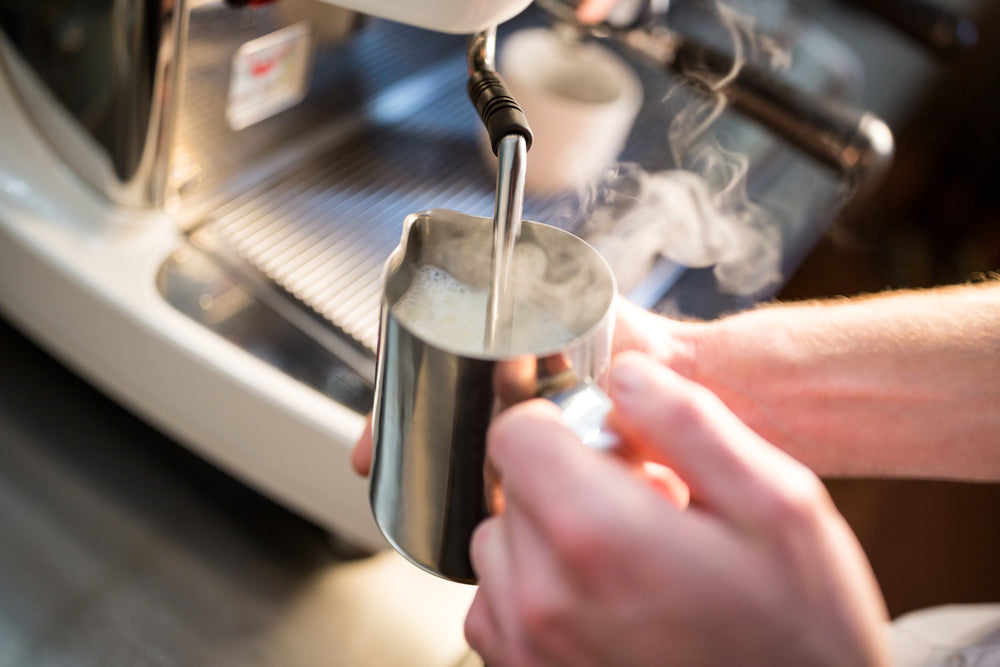
A Beginner's Guide to Steaming Milk
If you have recently invested in a coffee machine or are thinking of purchasing one, you have much to explore and learn if you are to craft truly amazing coffees.
Your chosen coffee beans will obviously influence your coffee drinking experience as will the type of drink that you favour. But the steamed milk that you add to your drinks could make all the difference. Whether you prefer smooth, velvety lattes or perfectly frothy cappuccinos, it is worth refining your steaming skills!
Here’s our handy beginner’s guide to steaming and frothing milk.
Which type of milk should you use?
The type of milk you choose will significantly impact the steaming process. It will also influence the taste of your beverages and their textures. Whole milk is perhaps the obvious choice as its high fat content delivers a wonderfully creamy texture. However, many baristas prefer to use semi-skimmed milk. The lower fat content of semi-skimmed milk reduces sweetness and so creates balanced drinks when added to espresso.
You might be surprised to hear that dairy milks vary greatly. You will discover noticeable differences between brands. This is because the molecular composition and taste of milks depend on which cows the milks have come from and what the animals were fed on. If you feel that your steamed milk isn’t quite hitting the spot, it would be worth trying milk from a different brand or store.
There are excellent non-dairy milk choices too including almond milk, oat milk and soy milk. These milks will produce different flavours that will alter the taste of your drinks. They each react differently to the steaming process and so you will need to tweak your technique for non-dairy options.
It is worth noting that cashew milks and hemp milks don’t tend to work well for coffees. Results with coconut milks vary. Some non-dairy milk brands now offer barista versions of their vegan milks. These are worth seeking out as they are formulated to prevent splitting and curdling to deliver the best froth.
Getting started
Before attempting to steam and froth milk, ensure that your espresso machine is clean and heated.
You will need a jug and it is important to select the right one. Choose a stainless steel jug that is the right size for the amount of milk that you wish to steam. You will find that the jug features a marker to indicate where to fill it to. If the jug is underfilled or overfilled, the milk won’t spin correctly during steaming.
Next, purge your steam wand into the drip tray to expel any trapped water.
What’s the difference between frothing and steaming milk?
Both frothing and steaming involve heating milk using a steam wand. But there’s a subtle difference between the two processes. Frothing is performed near the surface of the milk to create velvety bubbles. When steaming, the wand is submerged deeper into the milk to produce only a thin layer of foam on the top of the milk.
How do you position the steaming wand?
It is important that the steaming wand is resting against the spout of the jug throughout the steaming process. Submerge the steam wand into the milk, ensuring the tip is just below the surface. The tip of the steam wand needs to be at an angle. The correct angle is created by keeping the wand in contact with the milk jug spout and having the tip halfway between the outside wall of the jug and the centre of the jug.
How do you steam milk for a latte?
For the perfect latte, you need steamed milk with a small amount of foam.
- Use cold milk and a cold jug.
- Purge your steam wand.
- Fill the jug with milk up to the start of the spout.
- Submerge the tip of the steam wand just below the surface of the milk and froth until the pitcher feels warm to the touch.
- Then, lower the steam wand further into the milk, tilting the jug to create a vortex. Wait until the jug is almost painfully hot to the touch.
- Purge and clean the wand.
How to you froth milk for the ideal cappuccino?
For that special froth that completes a cappuccino, you need to create a dense microfoam.
- Use cold milk and a cold jug.
- Purge your steam wand.
- Fill the jug to 1cm below the start of the spout.
- Submerge the tip of the steam wand to just below the surface of the milk and froth until the milk almost doubles in volume. This process is known as aerating or stretching.
- Then, lower the steam wand further into the milk, tilting the jug to create a vortex. Wait until the pitcher is almost too hot to handle. This step is called texturing.
- Gently swirl the milk in the jug and tap against the counter to release bubbles.
- Purge and clean the wand.
How do you steam milk to create a flat white?
You will require a very thin microfoam for a flat white coffee. Follow the same steps as you would for creating a latte but introduce less air into the milk. This is achieved by keeping the wand close to the surface for just 2 seconds before submerging it deeper.
Top steaming tips
Here’s a few tips that will help you steam to perfection every time:
- Always use cold milk and a cold jug as cold milk is easier to froth.
- Heat the milk to no more than 65°C. At higher temperatures milk will burn and/or split.
- Leave room in the jug for the milk to expand.
- Always purge the steam wand before and after using it.
- Employing a continuous swirling motion as this will create more even bubbles.
Full steam ahead!
You can now steam your milk in confidence and craft the perfect coffees. It might take a few attempts to completely nail your steaming technique, but you will soon adapt to the nuances of the milk you are using. There’s nothing like the ideal coffee to lift your day.



Leave a comment